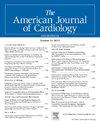Angiotensin Receptor-Neprilysin Inhibitors and Mortality Among Patients With HFrEF
IF 2.1
3区 医学
Q2 CARDIAC & CARDIOVASCULAR SYSTEMS
引用次数: 0
Abstract
While trial evidence supports the benefit of angiotensin receptor-neprilysin inhibitor (ARNI) therapy in heart failure with reduced ejection fraction (HFrEF), its effectiveness in routine clinical practice is less explored. This study investigated the relative and absolute effectiveness of ARNI in patients with HFrEF. This nationwide Danish database study included patients with left ventricular ejection fraction (LVEF) ≤40%, 2018 to 2023. Using a prevalent new user design, 2,446 ARNI initiators were matched 1:2 to 4,892 users of angiotensin-converting enzyme inhibitors (ACE-I) or angiotensin receptor blockers (ARB) based on propensity scores, age, LVEF, and NT-proBNP. The primary outcome was all-cause mortality; secondary outcomes were cardiovascular mortality and hospitalization. There were 279 deaths among ARNI initiators (5.6/100 person-years) and 533 among ACE-I/ARB users (6.7/100 person-years), yielding a hazard ratio (HR) of 0.85 (95% CI, 0.74 to 0.98) for all-cause mortality. A significant interaction was observed for recent hospitalization (p = 0.04), with ARNI yielding a lower HR in this group. HRs were otherwise consistent across age, sex, LVEF, NT-proBNP, NYHA class, ischemic heart disease, chronic kidney disease, and type 2 diabetes. The largest absolute mortality reductions were seen in subgroups with recent hospitalization, NYHA class III to IV, and severely elevated NT-proBNP. ARNI was also associated with a lower risk of cardiovascular death (HR, 0.81; 95% CI, 0.65 to 0.99), but not with other secondary outcomes. In this study, ARNI was associated with a 15% reduction in all-cause mortality vs ACE-I/ARB. Patients with advanced or symptomatic heart failure appeared to experience the greatest absolute benefit.
血管紧张素受体-奈普利素抑制剂与HFrEF患者的死亡率。
背景:虽然试验证据支持血管紧张素受体-neprilysin抑制剂(ARNI)治疗心力衰竭伴射血分数降低(HFrEF)的益处,但其在常规临床实践中的有效性尚不清楚。本研究探讨了ARNI在HFrEF患者中的相对和绝对有效性。方法:这项全国性的丹麦数据库研究纳入了2018-2023年左室射血分数(LVEF)≤40%的患者。采用流行的新用户设计,2446例ARNI启动者与4892例血管紧张素转换酶抑制剂(ACE-I)或血管紧张素受体阻滞剂(ARB)的用户根据倾向评分、年龄、LVEF和NT-proBNP进行1:2匹配。主要结局是全因死亡率;次要结局是心血管死亡率和住院率。结果:ARNI发起者中有279人死亡(5.6/100人年),ACE-I/ARB使用者中有533人死亡(6.7/100人年),全因死亡率的风险比(HR)为0.85 (95% CI, 0.74-0.98)。在最近的住院治疗中观察到显著的相互作用(p=0.04), ARNI在该组中产生较低的HR。hr在不同年龄、性别、LVEF、NT-proBNP、NYHA分类、缺血性心脏病、慢性肾病和2型糖尿病中是一致的。绝对死亡率下降幅度最大的亚组是近期住院、NYHA III-IV级和NT-proBNP严重升高的亚组。ARNI还与较低的心血管死亡风险相关(HR, 0.81; 95% CI, 0.65-0.99),但与其他次要结局无关。结论:在这项研究中,与ACE-I/ARB相比,ARNI与全因死亡率降低15%相关。晚期或有症状的心力衰竭患者似乎获得了最大的绝对益处。
本文章由计算机程序翻译,如有差异,请以英文原文为准。
求助全文
约1分钟内获得全文
求助全文
来源期刊

American Journal of Cardiology
医学-心血管系统
CiteScore
4.00
自引率
3.60%
发文量
698
审稿时长
33 days
期刊介绍:
Published 24 times a year, The American Journal of Cardiology® is an independent journal designed for cardiovascular disease specialists and internists with a subspecialty in cardiology throughout the world. AJC is an independent, scientific, peer-reviewed journal of original articles that focus on the practical, clinical approach to the diagnosis and treatment of cardiovascular disease. AJC has one of the fastest acceptance to publication times in Cardiology. Features report on systemic hypertension, methodology, drugs, pacing, arrhythmia, preventive cardiology, congestive heart failure, valvular heart disease, congenital heart disease, and cardiomyopathy. Also included are editorials, readers'' comments, and symposia.
 求助内容:
求助内容: 应助结果提醒方式:
应助结果提醒方式:


